

 | Page 1326 |  |
periods, and artists, of the rise, development, flourishing, and decline of the art of different nations, the whole connected with the attempt to classify each individual work of art. He exemplified this theory in his great work, his History of the Art of Antiquity in 1764, the work that marked the height of his fame. He described the art of the Egyptians, Phoenicians, Persians, and Parthians; of the Etruscans and Italians; as well as the style of Greek art, which he divided into four separate styles, the more ancient style, the grand, the beautiful, and the style of the imitators. He maintained that, besides nature, climate, and education, it was freedom that had produced the artistic flowering of Greece. In 1757 he became librarian at the Vatican and a year later entered the service of Alessandro Albani. In 1758 he visited Naples, Portici, herculaneum, and pompeii for the first time and went to the temple at Paestum. In 1762 his Remarks on the Architecture of the Ancients appeared and was instrumental in bringing the temple of Paestum to European attention. He saw that Vitruvius had not gone far enough in answering the question of the origins of Greek architecture and that its uniqueness and development could only be made clear through drawings and reproduction. In later writings, Open Letters from the Discoveries at Herculaneum (1762) and News of the Most Recent Herculanean Discoveries (1764), he reported on significant finds at Herculaneum and Pompeii. He also described in detail the Roman frescoes and artifacts from daily life and pointed out the artistic and aesthetic aspects of Roman handicrafts. In 1760 he published his Description of Ancient Gems by the late Baron de Stosch in Florence, which introduced methodologically significant elements into archaeology as he recognized that many of the themes or images taken from Greek mythology needed to be explained. In 1767 were published two volumes of Monumenti antichi inediti, in which he tested out his archaeological-hermeneutic methodology and tried to decipher the mystifying content of classical works, as well as attempting to determine their style and thus their date. In another work, Attempt at an Allegory, Particularly for Art (1766) Winckelmann undertook to provide artists with a supply of significant classical themes as a stimulus for their own works. Its impact was to help fertilize the intellectual ground for the rise of Neoclassicism in Europe. On 8 June 1768 he was murdered in Trieste.

Johann Joachim Winckelmann
(Ann Ronan Picture Library)
References
For references, see Encyclopedia of Archaeology: The Great Archaeologists, Vol. 1, ed. Tim Murray (Santa Barbara, CA: ABC-CLIO, 1999), pp. 51–63.
(1880–1960)
Charles Leonard Woolley was born in London and won a scholarship to New College, Oxford, where he studied humanities and theology. He graduated in 1904 and then traveled to Germany to study modern languages. In 1905, Woolley was appointed assistant to sir arthur evans, keeper of the ashmolean museum in Oxford.
Woolley traveled to the Near East in 1907 to excavate in nubia with D. Randall-MacIver from the university of pennsylvania museum. He excavated the Meroitic cemetery at Karanog, unearthing rich finds and receiving an excellent training in field archaeological methods and the management of excavations. In 1912, Woolley was appointed to lead a british museum expedition to Carchemish where he discovered Neo-Hittite
 |  |